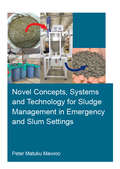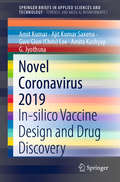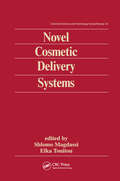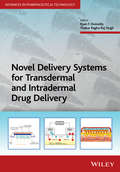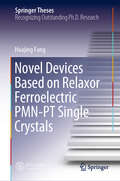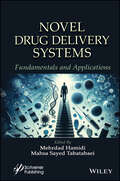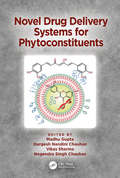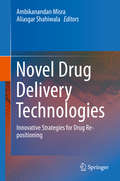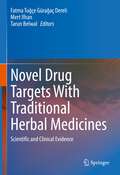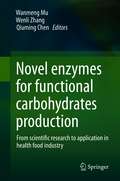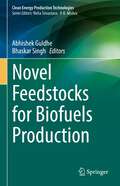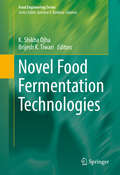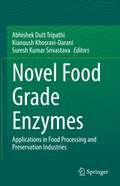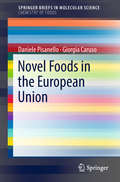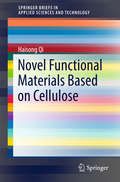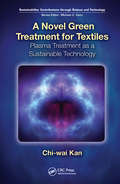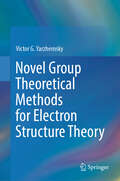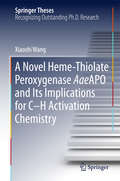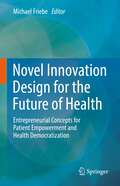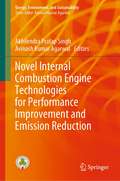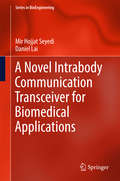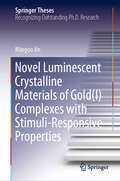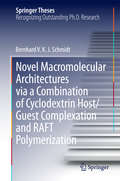- Table View
- List View
Novel Concepts, Systems and Technology for Sludge Management in Emergency and Slum Settings (IHE Delft PhD Thesis Series)
by Peter Matuku MawiooManagement of sludge is one of the most pressing issues in sanitation provision. The situation is especially complex when large quantities of fresh sludge containing various contaminants are generated in onsite sanitation systems in urban slums, emergency settlements and wastewater treatment facilities that require proper disposal of the sludge. The application of fast and efficient sludge management methods is important under these conditions. This study focused on the development of an innovative sludge treatment unit that is based on the microwave irradiation technology. The technology provides a rapid and efficient option for sludge treatment in isolated conditions such as slum, emergency, and similar situations. The microwave based technology forms part of the eSOS (emergency sanitation operation system) concept that promotes an integrated sanitation approach in which all components of the entire sanitation chain are planned holistically. Besides, the study addresses the deficiencies associated with the poor choice of emergency sanitation technology options by proposing a methodology that is based on compensatory multi-criteria analysis. This study contributes in providing solutions towards improved sanitation in complex scenarios, especially the management of faecal sludge in emergency and slum conditions.
Novel Coronavirus 2019: In-silico Vaccine Design and Drug Discovery (SpringerBriefs in Applied Sciences and Technology)
by Amit Kumar Ajit Kumar Saxena Gwo Giun Lee Amita Kashyap G. JyothsnaThis book highlights the genomic findings, observations, and analysis of DNA/RNA sequences and protein structure of the dreadful virus of this decade- COVID-19. The Corona group of viruses though known species, the strain that caused the Pandemic of 2019 is a completely new strain, belonging to the same corona family with a novel genetic make-up. This makes it a new pathogen which is causing the current outbreak leaving the global scientific community clueless of any therapeutic breakthrough. NCOV enjoys life threatening pathogenicity with mysterious genetic annotations. This book details and offers insights into its viral genetic arrangement, Virulence factors, probable mutations leading to the evolution of this new strain and more. It contains chapters on Virus evolutionary status and Genetic makeup leading to its pathogenicity which can be a new insight in understanding the nature of this clever microorganism and can pave way to the development of new drugs and Vaccines or a novel diagnostic approach for the early prognosis of the disease. A dedicated chapter on annotation of NCOV-19 virulence genes, translation of the genes to protein product, annotation of the antigenic sites on these proteins is also included. In all, this brief is a complete genomic annotation insight of NCOV-19 using AI, Data analytics and Bioinformatics analysis. In the current situation, this book is an extensive preliminary resource for Medical practitioners, Researchers, Academicians, Scientists, Biochemists, Bioinformaticians and other professionals interested in understanding the genetics of Novel Coronavirus 19, the best possible drug targets, ideal vaccine candidates and novel prognostic and diagnostic biomarkers.
Novel Cosmetic Delivery Systems (Cosmetic Science And Technology Ser. #19)
by Shlomo Magdassi Elka Touitou"Highlights the uses of delivery systems in cosmetics, analyzing new approaches for obtaining sophisticated cosmetic products and examining the most common methods for enhancing the skin's penetration properties. Covers a wide range of established and burgeoning techniques."
Novel Delivery Systems for Transdermal and Intradermal Drug Delivery
by Thakur Raghu Singh Ryan F. DonnellyThis research book covers the major aspects relating to the use of novel delivery systems in enhancing both transdermal and intradermal drug delivery. It provides a review of transdermal and intradermal drug delivery, including the history of the field and the various methods employed to produce delivery systems from different materials such as device design, construction and evaluation, so as to provide a sound background to the use of novel systems in enhanced delivery applications. Furthermore, it presents in-depth analyses of recent developments in this exponentially growing field, with a focus on microneedle arrays, needle-free injections, nanoparticulate systems and peptide-carrier-type systems. It also covers conventional physical enhancement strategies, such as tape-stripping, sonophoresis, iontophoresis, electroporation and thermal/suction/laser ablation Discussions about the penetration of the stratum corneum by the various novel strategies highlight the importance of the application method. Comprehensive and critical reviews of transdermal and intradermal delivery research using such systems focus on the outcomes of in vivo animal and human studies. The book includes laboratory, clinical and commercial case studies featuring safety and patient acceptability studies carried out to date, and depicts a growing area for use of these novel systems is in intradermal vaccine delivery. The final chapters review recent patents in this field and describe the work ongoing in industry.
Novel Developments for Sustainable Hydropower
by Peter Rutschmann Eleftheria Kampa Christian Wolter Ismail Albayrak Laurent David Ulli Stoltz Martin SchlettererThis open access book presents (selected) new and innovative developments for sustainable and fish-friendly hydropower. It offers unique insights into the challenges, practices and policies of hydropower developments across 8 European countries, providing examples from on-site studies and European-wide analyses. The case studies throughout the book are practical “real-world” examples, which are intended to serve as inspiration for anyone who would like to know more about how solutions for more sustainable hydropower production can be designed and implemented. Hydropower is an important renewable energy source, which, however, can also impact aquatic ecosystems, fish populations and hydro-morphology. EU and national water, environmental and energy legislation strive for sustainable energy and water resource management as well as the protection of important habitats and species. These have an effect on the requirements and decision making processes for hydropower planning, commissioning and operation. With a high variety of measures existing and site-specific conditions as well as national and EU level legal requirements to consider, it can be difficult to determine, what issues to address and which measures to implement.
Novel Devices Based on Relaxor Ferroelectric PMN-PT Single Crystals (Springer Theses)
by Huajing FangThis book explores the applications of ferroelectric materials in information technology by developing several prototype devices based on Pb(Mg1/3Nb2/3)O3-PbTiO3 (PMN-PT) single crystals. It describes how an optothermal field-effect transistor (FET) was constructed on the PMN-26PT single crystal, using a MoS2 monolayer as the channel semiconductor material. This fusion of pyroelectric effect and the interface engineering of 2D materials provides an effective strategy for the ‘photon revolution’ of FET. An ultra-broadband photodetector (UV ~ THz) was monolithically integrated into a [111]-oriented PMN-28PT single crystal by using silver nanowires in the transparent top electrode. The photodetector showed a dramatic improvement in operation frequency up to 3 kHz: an order of magnitude higher than that of traditional pyroelectric photodetectors. A self-powered integrated module was demonstrated through the combination of a triboelectric nanogenerator and a ferroelectric FET. The stored information can easily be written in the memory system using mechanical energy, solving the power consumption problem with regard to information writing in ferroelectric nonvolatile memories. This book extends the applications of ferroelectric single crystals into areas other than piezoelectric devices, paving the way for exciting future developments.
Novel Drug Delivery Systems: Fundamentals and Applications
by Mehrdad Hamidi Mahsa Sayed TabatabaeiThis book serves as a unique resource on the field of novel drug delivery systems (NDDSs), catering to both academic audiences (researchers, teachers, students) and industry professionals (pharmaceutical policymakers, managers, R&D, regulatory, business development, and marketing) involved in NDDSs. The evolving nature of diseases and the emergence of new health complications have driven a significant shift in drug therapy. Coupled with changes in human lifestyles and economic conditions, these factors have compelled the pharmaceutical industry to develop novel, efficient, and affordable drug products. The rise of promising technologies aimed at enhancing therapeutic performance further underscores the importance of novel drug delivery systems (NDDSs), making this field one of the most dynamic in pharmaceutical sciences today. This book offers a comprehensive exploration of NDDS applications, catering to both academic and industry professionals. It is designed to be both user-friendly and thorough, meeting the needs of diverse readers—from those seeking practical insights to those delving deeply into the field’s various sectors. The content has been meticulously compiled, organized, and analyzed by a team of experts to ensure accuracy, relevance, and currency. The book provides up-to-date information suitable for a broad audience, reflecting the wide scope of the NDDS field. The first section covers the foundational principles of NDDS, including their scientific and therapeutic basis, as well as the epidemiological and economic trends driving their development. Subsequent sections explore market-oriented aspects, such as global trends and projections. Chapters 3 to 12 present a taxonomy of NDDS categorized by their routes of administration. The book concludes with a forward-looking report on the potential future directions of NDDS. Written in clear, concise language, the book is accessible to non-native English readers, ensuring broad usability. Original figures, created by experts with scientific and graphic design expertise, enhance the reading experience and aid in understanding complex concepts. Audience A wide variety of professional readers from universities and other research institutions to health industries (industrial pharmaceutical and related), to the relevant high-tech startups to health and pharma policymakers and managers will be among the audiences of this book.
Novel Drug Delivery Systems for Phytoconstituents
by Madhu Gupta Durgesh Nandini Chauhan Vikas Sharma Nagendra Singh ChauhanNovel Drug Delivery Systems for Phytoconstituents discusses general principles of drug targeting, construction material and technological concerns of different phytoconstituent in delivery systems. It focuses on the development of novel herbal formulations and summarizes their method of preparation, type of active ingredients, route of administration, biological activity and their applications. It dicusses therapeutic activities of plant derived chemicals, their limitations in clinical applications and novel drug delivery solutions to overcome them to provide better therapeutic effects with controlled and targeted drug delivery. Focus on drug delivery of phytomolecules Act as bridge between natural product scientist and clinical doctors Discusses mechanism of poor bioavailability of herbal molecules Increases awareness towards phytochemical efficacy Summarizes efficient novel delivery systems-based formulations. It extensively covers the applications of novel drug delivery systems including polymeric nanoparticles, solid lipid nanoparticles, nanostructured lipid capsules, liposomes, phytosomes, microsphere, transferosomes, and ethosomes. Some chapters are especially focused on anticancer phytodrugs, silymarin, andrographolide, berberine, and curcumin delivery with special emphasis on their application.
Novel Drug Delivery Technologies: Innovative Strategies for Drug Re-positioning
by Ambikanandan Misra Aliasgar ShahiwalaThe application of drug delivery is a valuable, cost-effective lifecycle management resource. By endowing drugs with new and innovative therapeutic benefits, drug delivery systems extend products’ profitable lifecycle, giving pharmaceutical companies competitive and financial advantages, and providing patients with improved medications. Formulation development is now being used to create new dosage forms for existing products, which not only reduces the time and expense involved in new drug development, but also helps with regard to patent protection and bypassing existing patents. Today’s culture demands convenience, a major factor determining adherence to drug therapy. Over the past few years, patient convenience-oriented research in the field of drug delivery has yielded a range of innovative drug-delivery options. As a result, various drug-delivery systems, including medicated chewing gums, oral dispersible tablets, medicated lozenges and lollipops, have now hit the market and are very popular. These dosage forms offer a highly convenient way to dose medications, not only for special population groups with swallowing difficulties, such as children and the elderly, but for the general populace as well. This book provides valuable insights into a number of formulation design approaches that are currently being used, or could be used, to provide new benefits from existing drug molecules.
Novel Drug Targets With Traditional Herbal Medicines: Scientific and Clinical Evidence
by Fatma Tuğçe Gürağaç Dereli Mert Ilhan Tarun BelwalThis book collects information about the most popular ethnomedicinal plants, which are common in Turkey and around the world. It presents the ethnopharmacological records, in vivo and in vitro studies, side effects, chemical compositions and clinical studies of these medicinal plants. Its special focus is on the novel drug targets for disease and their possible mechanisms of action. It covers botanical descriptions the status of the plants, and food or drug interactions including precautions and warnings about the plants and the available market products. It provides an explanation of recorded and known plant administration dosages. Also, the gap between the traditional practice and scientific/clinical evidences in the use of ethnomedicinal plant is acknowledged.It is well known that traditional knowledge of the use of the medicinal plants in therapy is an important resource for the discovery of novel treatment options and drug targets. The main purpose of this book is to draw attention to ethnomedicinal plant species. Data on the therapeutic potentials of these medicinal plants can now be accessed from a single source. It provides an important resource for future research opportunities for harnessing the full potential of these plants.
Novel enzymes for functional carbohydrates production: From scientific research to application in health food industry
by Wanmeng Mu Wenli Zhang Qiuming ChenThis book focuses on the latest research and new techniques in the field of functional carbohydrate-related enzymes. Carbohydrates are a key form of energy for most organisms. The “good” carbohydrates generally refer to functional carbohydrates. In addition to the low or moderate energy-supplying function, they have more nutritious value than traditional carbohydrates and some of them also have health-promoting effects especially prebiotic actions. Several enzymatic methods for the synthesis of such carbohydrates have been discovered and developed in the recent decades, providing a new range of application areas for these novel enzymes. This book addresses the classification of functional carbohydrate-related enzymes and the overall development in food enzyme in Chapter 1. Chapters 2-5 describe the isomerases or epimerases involved in the production of rare sugars, such as D-allulose, D-mannose, D-tagatose, and D-allose. While the studies of the enzymes related to fructo-oligosaccharides (FOS) and galacto-oligosaccharides (GOS) dominate the scientific literature in the field of enzymatic production of health-functional oligosaccharides, some enzymes also show promise for the emerging oligosaccharide production, which are introduced in Chapters 6-8. Chapters 9-12 summarize the new enzymatic technologies and applications in fructan- and glycan-related industries. The last Chapter gives an overall prospective on the trends of enzymatic functional carbohydrate production. This book is a valuable resource for researchers and graduate students in the fields of biotechnology, enzyme engineering, and carbohydrate production, as well as the health industry.
Novel Feedstocks for Biofuels Production (Clean Energy Production Technologies)
by Abhishek Guldhe Bhaskar SinghThis book critically evaluates recently investigated feedstock for biofuels production. Biofuel sector is rapidly evolving to cater the renewable energy demands. Novel and advanced feedstock are being investigated for their techno-economic feasibility. Environmental concerns, food vs fuel debate, energy security, economic feasibility, and availability are the major drivers for exploring different feedstock for biofuel production. This book explores a wide range of potential biofuels feedstock, their functional concepts, recent advancement, novel technique and critical evaluation with other available biofuel feedstock. This book also discusses future prospects of biofuel production. It is a useful read for students, researchers, faculty, industry and policy makers in the biofuel field.
Novel Food Fermentation Technologies
by K. Shikha Ojha Brijesh K. TiwariNovel Food Fermentation Technologies provides a comprehensive overview of innovations in food fermentation technologies and their application. Current novel technologies for microbial culture production and preservation are covered in detail, as are fermentation techniques for the production of bioactives from various food matrices, including food processing by-products and waste. Readers are provided with a close look at thermal and non-thermal technologies applicable to fermented food products. The text covers immobilization, microencapsulation technologies, and novel preservation techniques for cultures in fermentation. In-depth studies of high pressure processing, pulsed electric field, power ultrasound and gamma irradiation in fermentation are provided in addition to novel thermal and non-thermal technologies and process analytical techniques. A wide variety of fermented products are covered, including meat, marine-based, grain-based, dairy, and vegetable-based products. Current technologies for extraction of bioactives are examined, as are current innovations in fermented food packaging. Readers are presented with current and future challenges in food fermentation as well. As a comprehensive reference for food fermentation, this work provides up-to-date insights into emerging fermentation technologies which facilitate the processing of wholesome and safe food products.
Novel Food Grade Enzymes: Applications in Food Processing and Preservation Industries
by Abhishek Dutt Tripathi Kianoush Khosravi-Darani Suresh Kumar SrivastavaThis book covers all the aspects of food-grade enzymes, including their classification, kinetics, microbial production, biosynthetic pathways, commodity-wise industrial applications, and downstream processing strategies. The broad focus of this book is on the application of various classes of enzymes in dairy, fruits and vegetables, cereals and oilseeds, meat and poultry, and brewing and food packaging industries. Certain recent areas such as nanotechnological perspective in enzyme immobilization, infusion strategies as well as its efficient usage in food packaging and preservation are some of the salient highlights of this book. This book also discusses the aspects related to application of enzymes in functional food development and shelf life extension of various commodities food products. This book is beneficial for researchers, students, entrepreneurs, and industry experts in broad disciplines such as food processing, food biotechnology, food microbiology, biochemistry, agriculture, biotechnology, biochemical engineering, and bioprocess technology.
Novel Foods in the European Union (SpringerBriefs in Molecular Science)
by Daniele Pisanello Giorgia CarusoThis Brief describes in three concise chapters one of the newest ‘hot topics’ under EU Food Law and Policy: the new Regulation (EU) No 2015/2283 from the European Parliament and by the Council, November 25, 2015, on novel foods, applicable from January 2018. In this work, the Authors discuss the long-time criticized EU Regulation on novel foods ((EC) No 258/1997) and how it has been significantly altered by the adoption of the new regulation. In the first chapter, the Authors provide a comprehensive analysis of the genesis of the new Regulation, its rationale and the policy’s goals. In particular, they describe what food business operators shall do in order to get a new product allowed on the EU market, providing updated information on the regulatory developments from the European Food Safety Authority in nanofoods, cloned animals and insect foods. The role of the European Food Safety Authority is also discussed. The second Chapter summarizes the current toxicological studies used to evaluate novel foods safety, which are an extremely important pillar when speaking of food safety and commercial introduction of new products. Finally, the third Chapter discusses the ‘history of safe use’ approach to the problem of novel foods, and factors such as consumption period analysis, preparation advices and processes, intake levels, nutritional composition, and results of animal studies. Food lawyers, professionals and auditors working in the area of official inspections, quality assurance, food traceability, and international regulation, both in academia and industry, will find this Brief an important account.
Novel Functional Materials Based on Cellulose
by Haisong QiThis Brief presents a review of new eco-friendly processes, design and applications for novel cellulose-based materials, including regenerated materials, composites, nanocellulose and cellulose derivatives. Application of these materials in smart textiles, packaging, energy storage, sensors, gas separations, tissue engineering and drug release are highlighted.
A Novel Green Treatment for Textiles: Plasma Treatment as a Sustainable Technology (ISSN)
by Chi-wai KanIndustries worldwide have been impacted by environmental regulations, economics, and ultimately consumers, which has led to more thought about the development of sustainable products. The textile industry is no exception. The preparation, dyeing, and finishing of textile fibres requires large amounts of water and other chemicals which may be toxic
Novel Group Theoretical Methods for Electron Structure Theory
by Victor G. YarzhemskyThis book presents the induced representation method, a powerful technique in quantum mechanics with applications in condensed matter physics. After introducing the key concepts in group theory and representation theory necessary to understate the technique, the author goes on to explore applications in electron structure theory, namely: basis sets in clusters, normal vibrations, selection rules, two-electron wavefunctions, and space-group representations. This technique allows the simplification of standard techniques for the analysis of molecular orbitals and normal vibrations of molecules. A space group approach to the wavefunction of a Cooper pair based on the Anderson ansatz and Mackey-Bradley theorem is developed, and several applications are considered, namely group-theoretical nodes, non-symmorphic groups, and unification of the group theoretical and topological approaches to the structure of Cooper pairs in unconventional superconductors.
A Novel Heme-Thiolate Peroxygenase AaeAPO and Its Implications for C-H Activation Chemistry (Springer Theses)
by Xiaoshi WangIn this thesis, Xiaoshi Wang investigates the function and mechanism of a newly discovered heme-thiolate peroxygenase, AaeAPO. This enzyme class comes from Agrocybe aegerita and is used in the conversion of inert hydrocarbons to alcohols. Xiaoshi's work focuses on an extracellular P450 enzyme which is not limited in its stability and lack of solubility and therefore is relevant for widespread industrial use. The author demonstrates that the peroxygenase catalyzes a wide range of reactions. In some cases the author even describes very difficult transformations in molecules that are highly inert. Her detailed investigations provide a mechanistic framework for how the peroxygenase catalyzes such a large number of reactions. A major highlight of this thesis is the identification of key short-lived intermediates in the catalytic cycle of the peroxygenase, using rapid kinetic and spectroscopic methods, as well as the elucidation of the thermodynamic properties of these high-energy intermediates. This work adds new insight into an important class of enzymes.
Novel Innovation Design for the Future of Health: Entrepreneurial Concepts for Patient Empowerment and Health Democratization
by Michael FriebeThis book highlights the reasons for an urgently needed revision of the current global healthcare setup, discusses the needed mindset for a future of health, and provides a comprehensive development toolset for disruption (and for the needed incremental innovations towards disruption).Today’s biomedical and health innovation related research in universities encourages activities that lead to incremental innovations with a relatively low risk of failure. The healthcare industry on the other hand provides tools and devices for established healthcare providers to improve the diagnosis and therapy/ treatment of the patients’ health problems. The patient is not in the center of healthcare provision however, and prevention and prediction are not core goals. The current health setup needs to be challenged and disrupted.Disruptions are coming from technologies or processes that lead to a significant (>10x) reduction in cost or price/ performance and that also come with new business models. The need for change, effects of exponential technologies, and the needed shift to prevention and to homecare for health democratization and patient empowerment will be discussed in detail in the first parts of the book. The subsequent sections address several innovation methods with a focus on a novel meta methodology named Purpose Launchpad Health. This is followed by a comprehensive discussion on health entrepreneurship activities and needs. The final section of the book addresses how to train students to become entrepreneurial health innovators, presenting successful curricula and examples of health incubation and accelerator setups. All of the innovation tools presented and used in this book are summarized in the final chapter to help the reader get started planning an entrepreneurial venture.Written by experts from academia and industry, the book covers important basics and best practices, as well as recent developments. Chapters are concise and enriched with key messages, learning objectives and real innovation examples to bridge theory and practice. This book aims to serve as a teaching base for health innovation design and to prepare for health-related entrepreneurial ventures.Readers with medical, biomedical, biotechnology, and health economics backgrounds - and anyone who wants to become a future oriented health innovator or who believes in disruptive approaches - will find this book a useful resource and teaching tool for developing validated products/ services and processes for the future of health.
Novel Internal Combustion Engine Technologies for Performance Improvement and Emission Reduction (Energy, Environment, and Sustainability)
by Akhilendra Pratap Singh Avinash Kumar AgarwalThis monograph covers different aspects of internal combustion engines including engine performance and emissions and presents various solutions to resolve these issues. The contents provide examples of utilization of methanol as a fuel for CI engines in different modes of transportation, such as railroad, personal vehicles or heavy duty road transportation. The volume provides information about the current methanol utilization and its potential, its effect on the engine in terms of efficiency, combustion, performance, pollutants formation and prediction. The contents are also based on review of technologies present, the status of different combustion and emission control technologies and their suitability for different types of IC engines. Few novel technologies for spark ignition (SI) engines have been also included in this book, which makes this book a complete solution for both kind of engines. This book will be useful for engine researchers, energy experts and students involved in fuels, IC engines, engine instrumentation and environmental research.
A Novel Intrabody Communication Transceiver for Biomedical Applications (Series in BioEngineering)
by Mir Hojjat Seyedi Daniel LaiThis monograph explores Intrabody communication (IBC) as a novel non-RF wireless data communication technique using the human body itself as the communication channel or transmission medium. In particular, the book investigates Intrabody Communication considering limb joint effects within the transmission frequency range 0. 3-200 MHz. Based on in-vivo experiments which determine the effects of size, situations, and locations of joints on the IBC, the book proposes a new IBC circuit model explaining elbow joint effects. This model not only takes the limb joint effects of the body into account but also considers the influence of measurement equipment in higher frequency band thus predicting signal attenuation behavior over wider frequency ranges. Finally, this work proposes transmitter and receiver architectures for intrabody communication. A carrier-free scheme based on impulse radio for the IBC is implemented on a FPGA.
Novel Lights Sources Beyond Free Electron Lasers (Particle Acceleration and Detection)
by Andrei Korol Andrey V. Solov'yovThis book discusses possibilities and perspectives for designing and practical realization of novel intensive gamma-ray crystal-based light sources that can be constructed through exposure of oriented crystals—linear, bent and periodically bent, to beams of ultrarelativistic positrons and electrons.The book shows case studies like the tunable light sources based on periodically bent crystals that can be designed with the state-of-the-art beam facilities. A special focus is given to the analysis of generation of the gamma rays because the current technologies based on particle motion in the magnetic field become inefficient or incapable to achieve the desired gamma rays’ intensities. It is demonstrated that the intensity of radiation from crystal-based light sources can be made comparable to or even higher than what is achievable in conventional synchrotrons and undulators operating although in the much lower photon energy range. By exploring the coherence effects, the intensity can be boosted by orders of magnitude. The practical realization of such novel light sources will lead to the significant technological breakthroughs and societal impacts similar to those created earlier by the developments of lasers, synchrotrons and X-rays free-electron lasers.Readers learn about the underlying fundamental physics and familiarize with the theoretical, experimental and technological advances made during last two decades in exploring various features of investigations into crystal-based light sources. This research draws upon knowledge from many research fields, such as material science, beam physics, physics of radiation, solid-state physics and acoustics, to name but a few. The authors provide a useful introduction in this emerging field to a broad readership of researchers and scientists with various backgrounds and, accordingly, make the book as self-contained as possible.
Novel Luminescent Crystalline Materials of Gold (Springer Theses)
by Mingoo JinThis book highlights and investigates novel solid-state luminescent properties of crystals with stimuli-responsive behavior. Several novel molecular designs for controlling crystal structures with photo-physical properties are described, with a special focus on external stimuli-responsive properties. The major goal of the material design concept was to capitalize on the chirality of crystals with stimuli-responsive properties. To allow crystals’ chirality to be controlled and modified by means of external stimulation, the axial chirality of biaryl moiety was employed and, interestingly, produced several novel mechano- and vapo-responsive luminescent properties based on crystal-to-crystal or single-crystal-to-single-crystal phase transitions. In addition, the book details how the molecular rotation of luminophores in the solid phase can be used to achieve corresponding thermal-responsive phosphorescence. The reports presented here illustrate how the author has succeeded in controlling structural factors in a bulk environment by using molecular design with linking to photo-physical properties. The content will be of great interest to researchers in the field, and to members of chemical and material science societies.
Novel Macromolecular Architectures via a Combination of Cyclodextrin Host/Guest Complexation and RAFT Polymerization
by Bernhard V. K. J. SchmidtIn this thesis, Bernhard Schmidt describes his research into two fields in the chemical sciences: supramolecular and macromolecular chemistry. Schmidt first investigates cyclodextrins (CDs), which are well known for the formation of supramolecular host/guest complexes with hydrophobic molecules in aqueous solution. Schmidt then also examines reversible addition-fragmentation chain transfer (RAFT) polymerization as a well-suited toll for the synthesis of water-soluble end-functionalized polymers. The author skillfully combines both concepts as a powerful tool to access reversibly forming macromolecular architectures. The novel methods and architectures presented in this work are highly interesting from both a fundamental point of view as well as a basis for the design of efficient drug release systems. The work in this thesis has led to a number of publications in top peer-reviewed journals.
